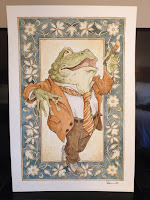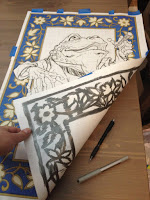Tomorrow sees the release of Archaia publishing's Mouse Guard: The Art of Bricks showcasing the wonderful LEGO display put on by ARCHLUG (the Seattle LEGO Builder Club). The display was originally built and displayed in 2015 and then was updated and shown again in 2016 at the Emerald City Comic Con. For the fans of LEGO or Mouse Guard who couldn't make it to those events, or want to admire the work again, this photo art book is a full look at Mouse Guard in Brick form.
I have written a foreword for the book. And to accompany it, I drew a pinup image of the Guardmice in Brick-form. Today's blogpost will go through the steps in creating that piece. I started by pulling down my LEGO model of the Matriarch chamber given to me at ECCC'15 by Alice Finch. I used the Mouse Guard mini-figs that Guy Himber at Crazy Bricks sent me to set a scene of familiar mice gathered around Gwendolyn.
 After I took a photo of the diorama model, I cropped and enlarged it to suit the format of the square book, and then printed it out to-scale. On my light box I traced over the printout on a clean sheet of paper to get my drawing. Normally, I don't like blatantly tracing reference photos. I've done it in the past, and it's a shortcut that often does more harm than good (it sticks out like a sore thumb, you don't usually have photo reference from other angles, and it's a crutch that is easy to grow accustomed to.) However, because of the precise geometric nature of LEGO and the deadline on this piece, I did exactly that.
After I took a photo of the diorama model, I cropped and enlarged it to suit the format of the square book, and then printed it out to-scale. On my light box I traced over the printout on a clean sheet of paper to get my drawing. Normally, I don't like blatantly tracing reference photos. I've done it in the past, and it's a shortcut that often does more harm than good (it sticks out like a sore thumb, you don't usually have photo reference from other angles, and it's a crutch that is easy to grow accustomed to.) However, because of the precise geometric nature of LEGO and the deadline on this piece, I did exactly that.(Note: I still had to figure out the vanishing point to make some corrections as I went)
 The next step, once I had a clean line drawing, was to ink the piece. I taped my pencils to the back of a sheet of Strathmore 300 series bristol. And seated at my lighbox again, I started inking with Copic Multiliner SP pens. I made an effort to add some texture, dings, dents, and line weights so that the end result didn't look like a traced technical drawing.
The next step, once I had a clean line drawing, was to ink the piece. I taped my pencils to the back of a sheet of Strathmore 300 series bristol. And seated at my lighbox again, I started inking with Copic Multiliner SP pens. I made an effort to add some texture, dings, dents, and line weights so that the end result didn't look like a traced technical drawing.I also made an effort to not use a ruler and draw every line straight. For the floor I tried to emulate some of the LEGO tiles poping up a bit.
 After the inks were completed, I started flatting the colors in Photoshop. I pulled up a color chart for the official LEGO brick colors to use for my palette, but found it a bit too restrictive and used it as a guideline instead. You'l notice the weapons, books, and some miscellaneous items are drastically the wrong color. I'll often do that with all the little fiddly bits of minutia so make sure I got it all flatted. I then will desaturate that later and color each item as need be.
After the inks were completed, I started flatting the colors in Photoshop. I pulled up a color chart for the official LEGO brick colors to use for my palette, but found it a bit too restrictive and used it as a guideline instead. You'l notice the weapons, books, and some miscellaneous items are drastically the wrong color. I'll often do that with all the little fiddly bits of minutia so make sure I got it all flatted. I then will desaturate that later and color each item as need be. The last step is to do the final rendering. Because these are supposed to be like LEGO, I went a bit more drastic on the highlights than I normally would. I used the Dodge tool to add those highlights and the shadows were applied using the Burn tool (I used a textured brush with both). For the weapons, I didn't follow the LEGO tendency to have a single color of molded plastic (only getting multiple colors with stamp printed details) in favor of making the items look more like their Mouse Guard comic counterparts.
The last step is to do the final rendering. Because these are supposed to be like LEGO, I went a bit more drastic on the highlights than I normally would. I used the Dodge tool to add those highlights and the shadows were applied using the Burn tool (I used a textured brush with both). For the weapons, I didn't follow the LEGO tendency to have a single color of molded plastic (only getting multiple colors with stamp printed details) in favor of making the items look more like their Mouse Guard comic counterparts.This pinup, along with my foreword and some special brick endpapers (see in-process image below) will be included in Mouse Guard The Art of Bricks out this June.
On Sale: June 29 2016
-Price: $34.99
-Page Count: 240
2016 Appearances:


































